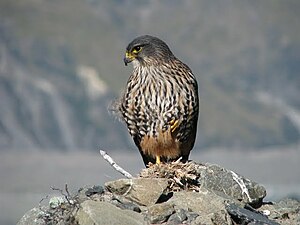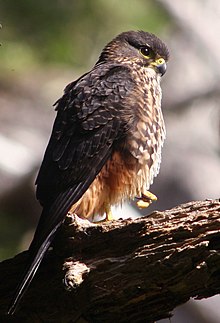Maori falcon
| Maori falcon | ||||||||||||
|---|---|---|---|---|---|---|---|---|---|---|---|---|

Maori falcon, male |
||||||||||||
| Systematics | ||||||||||||
|
||||||||||||
| Scientific name | ||||||||||||
| Falco novaeseelandiae | ||||||||||||
| Gmelin , 1788 |

The Maori falcon ( Falco novaeseelandiae ) is a bird of the falcon-like family (Falconidae). This medium-sized hawk is endemic to New Zealand . The Maori falcon feeds mainly on birds, but also eats mammals, lizards and insects and very rarely also carrion. The population of the species is presumably declining due to habitat destruction and probably also due to direct persecution, the Maori falcon is therefore listed by the IUCN as a type of the warning list ("near threatened").
description
Maori falcons are medium-sized, sturdy built falcons with relatively short wings and a rather long tail. The body length is 36–48 cm, the wingspan 66–91 cm. Like many species of the genus Falco , the Maori falcon shows a very strong reverse sexual dimorphism in terms of size and weight, but similar to other larger falcon species, not in terms of color. Adult males weigh 252–500 g and have a wing length of 226–267 mm. Adult females reach a weight of 420-594 g and a wing length of 246-308 mm, on average 371 mm.
The color of the adult males is quite appealing in color, and the skull, upper side of the trunk and the upper wing-coverts are bluish black. The coverts on the back and upper wings have narrow reddish to whitish edges, these areas therefore appear finely scaled. The underside of the fuselage and the under wing-coverts are predominantly darkly dashed on a cream-colored background, only strongly transversely banded on the flanks. The leg fletching and the tail-coverts are similar to those of the tree falcon, a strong reddish brown. The wings and control feathers are finely reddish to whitish transversely banded on top on a dark brown background, these bands are much wider and clearer below. The head shows a clear streak of beard on the sides, cheeks and throat are darkly dashed on a reddish background. There is a narrow, reddish brow streak above the eye.
Females are similar to males, but are even darker on the upper side than males with less blue, especially on the head, sometimes missing scaling and banding of the back and upper wings. The underside is also often darker than that of the male due to even more pronounced dashing and banding.
Birds in youthful dress are dark brown-black on the top. Many individuals are monochrome and dark on top, but especially males still show fine, light banding on the wings and control feathers. The color of the underside is variable depending on the population. In light-colored animals it is similar to that of adult birds, but the beard is finer, the cheeks less light and the trunk is generally darker and not banded on the flanks. In dark individuals, the head markings are reduced to the reddish stripe above the eyes and a light dashed line on the cheeks, the trunk is almost a monochrome dark brown with reddish spots and lighter spots on the flanks. The leg fletching is dark red-brown, the throat is cream to rust-colored.
The iris is dark brown in all clothes, the eye ring, wax skin and legs are yellow in adult birds, pale blue, gray or olive green in juvenile dress. The claws are black.
The Maori falcon is unmistakable in New Zealand because it is the only species of bird of prey that can be found there alongside the marsh harrier .
distribution and habitat
The species is endemic to New Zealand. It occurs almost everywhere there, only on the Northland peninsula is it limited to small areas. The original habitat of the Maori falcon was the primeval forests and dense bushland that were previously predominant. However, the species has proven to be very adaptable and now also colonizes commercial forests and, above all, the extensive grassland with few bushes that was created through extensive clearing and mainly used for sheep breeding. The species occurs from sea level up to 1500 m, locally up to 2100 m altitude.
Systematics
No subspecies are recognized for the Maori falcon, but three "forms" have been described that differ in terms of distribution, habitat, size and color.
- "Forest form" ("Bush"): relatively dark, wing length in males on average 236 mm and weight on average 264 g, wing length in females on average 273 mm and weight on average 474 g; North Island and Northwest of the South Island .
- "Grassland" or "Eastern Falcon": Larger and lighter than the forest shape; Wing length in males on average 255 mm and weight on average 330 g, wing length in females on average 297 mm and weight on average 531 g; eastern parts of the South Island.
- "Southern Falcon": size between forest and grassland form, but as dark as the latter; Fiordland , Stewart Island with minor islands and Auckland Islands .
Hunting style and diet
Maori falcons hunt from a hide as well as from the Hohe Kreis or from flight close to the ground or in a winding flight between trees. Prey is attacked in a dive on the ground, but more often pursued and grasped in the air. The food spectrum used for a falcon is extraordinarily wide, both in terms of species spectrum and in terms of the size of the prey. It consists mainly of small to medium-sized birds weighing 10 g to about 1000 g, but also of mammals up to the size of adult hares up to a weight of about 3 kg and insects. Reptiles, especially lizards, and very rarely carrion are eaten less often.
Reproduction
The breeding season extends from September to February. Like all falcons, the species does not build nests; in forests, ground hollows under dead wood or in dense vegetation, epiphytes on dead or dying trees or, rarely, tree hollows are used for breeding . The falcons of the open country breed on ledges in rock walls or on steep slopes on the ground at the foot of boulders.
The clutch consists of 2–4 eggs. The incubation period is probably 29–35 days, the nestling period 32–35 days. The young birds are independent at the age of two to three months.
hikes
Directed or regular hikes are not known. Adult birds are mostly stationary birds , young birds continue to roam. Wandering guests were still observed on Campbell Island , 250 km south of the Auckland Islands, which are still inhabited by the species.
Existence and endangerment
Relatively precise estimates are available for the existence of the three forms. The forest form is estimated to be around 650 pairs, that of the grassland form around 3150 pairs and that of the southern form around 200 pairs. The population of the species is threatened primarily by habitat destruction and probably also by direct persecution. Another threat is the introduced brushless kusu ( Trichosurus vulpecula ), which eats clutches. The population is presumably declining, but a clear population trend has not yet been proven. The Maori falcon is listed by the IUCN as a type of warning list ("near threatened").
Others
The Maori hawk is depicted on the back of the New Zealand $ 20 banknote . Twice it was also the subject of New Zealand postage stamps .
swell
Individual evidence
- ^ J. Ferguson-Lees, DA Christie: Raptors of the World. Christopher Helm, London 2001, p. 286.
- ^ J. Ferguson-Lees, DA Christie: Raptors of the World. Christopher Helm, London 2001, p. 894.
- ^ J. Ferguson-Lees, DA Christie: Raptors of the World. Christopher Helm, London 2001, p. 894.
- ↑ BirdLife International (2009) Species factsheet: Falco novaeseelandiae. Retrieved online from http://www.birdlife.org/ on December 11, 2009
literature
- J. Ferguson-Lees, DA Christie: Raptors of the World. Christopher Helm, London 2001, ISBN 0-7136-8026-1 , pp. 286-287 and 893-894.
Web links
- Falco novaeseelandiae in the Red List of Threatened Species of the IUCN 2008. Posted by: BirdLife International, 2008. Accessed January 2 of 2009.
